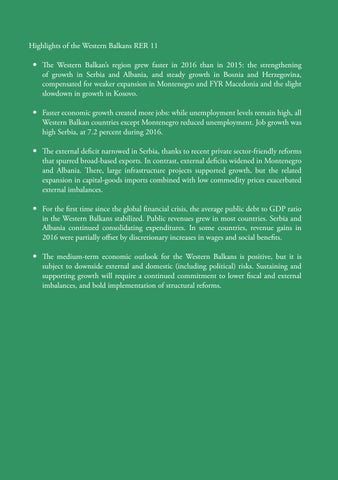Highlights of the Western Balkans RER 11 yy The Western Balkan’s region grew faster in 2016 than in 2015: the strengthening of growth in Serbia and Albania, and steady growth in Bosnia and Herzegovina, compensated for weaker expansion in Montenegro and FYR Macedonia and the slight slowdown in growth in Kosovo. yy Faster economic growth created more jobs: while unemployment levels remain high, all Western Balkan countries except Montenegro reduced unemployment. Job growth was high Serbia, at 7.2 percent during 2016. yy The external deficit narrowed in Serbia, thanks to recent private sector-friendly reforms that spurred broad-based exports. In contrast, external deficits widened in Montenegro and Albania. There, large infrastructure projects supported growth, but the related expansion in capital-goods imports combined with low commodity prices exacerbated external imbalances. yy For the first time since the global financial crisis, the average public debt to GDP ratio in the Western Balkans stabilized. Public revenues grew in most countries. Serbia and Albania continued consolidating expenditures. In some countries, revenue gains in 2016 were partially offset by discretionary increases in wages and social benefits. yy The medium-term economic outlook for the Western Balkans is positive, but it is subject to downside external and domestic (including political) risks. Sustaining and supporting growth will require a continued commitment to lower fiscal and external imbalances, and bold implementation of structural reforms.
Issuu converts static files into: digital portfolios, online yearbooks, online catalogs, digital photo albums and more. Sign up and create your flipbook.
